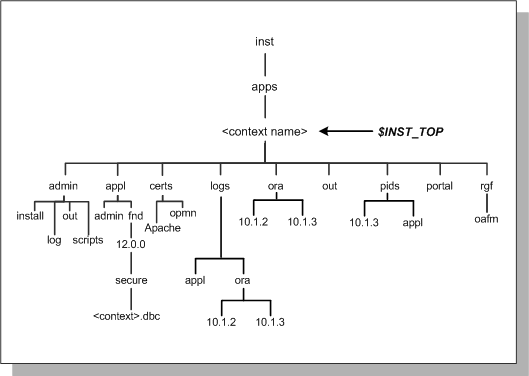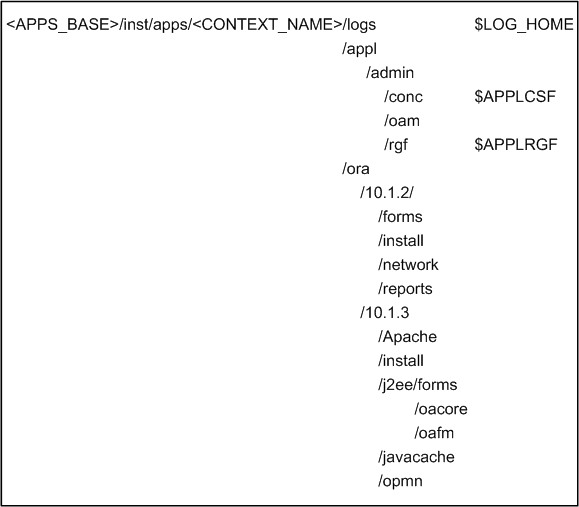Oracle E-Business Suite Release 12 introduces the concept of a top-level directory for an Oracle E-Business Suite instance. This directory is referred to as the Instance Home, and denoted by the environment variable $INST_TOP.
Using an Instance Home provides the ability to share application and technology stack code among multiple instances, for example a development instance and a test instance. Other benefits include support for read-only file systems and centralization of log files, both of which are discussed further below.
The basic structure of the instance home is: <APPS_BASE>/inst/apps/<context_name>, where APPS_BASE (which does not have or need a corresponding environment variable) is the top level of the Oracle E-Business Suite installation, and <context_name> is the highest level at which the applications context exists. For example, the setting of $INST_TOP might be <diskresource>/applmgr/inst/apps/testsys2, where testsys2 is the context name.
All configuration files created by AutoConfig are stored under the Instance Home. This facilitates use of a shared application tier file system, as described later in this chapter.
Figure 2-2 Instance Top

Note: In a shared file system environment, Oracle recommends that the INST_TOP should be located on a local disk and not on a shared resource such as NFS, because of possible issues storing log files on shared resources.
Important: This is particularly significant from a security perspective, as log files may contain sensitive data that should not be accessible to general users.
The following diagram shows the directory structure used for log files in Release 12, with some of the subdirectories used to categorize the log files:
Figure 2-3 Log Files

Using an Instance Home provides the ability to share application and technology stack code among multiple instances, for example a development instance and a test instance. Other benefits include support for read-only file systems and centralization of log files, both of which are discussed further below.
The basic structure of the instance home is: <APPS_BASE>/inst/apps/<context_name>, where APPS_BASE (which does not have or need a corresponding environment variable) is the top level of the Oracle E-Business Suite installation, and <context_name> is the highest level at which the applications context exists. For example, the setting of $INST_TOP might be <diskresource>/applmgr/inst/apps/testsys2, where testsys2 is the context name.
All configuration files created by AutoConfig are stored under the Instance Home. This facilitates use of a shared application tier file system, as described later in this chapter.
Figure 2-2 Instance Top

Read-Only File Systems
A key benefit of moving to the new Instance Home model is that as AutoConfig no longer writes to the APPL_TOP or ORACLE_HOME directories, both of these can be made into read-only file systems if required. In previous Oracle E-Business Suite releases, the adpatch utility wrote to $APPL_TOP/admin on an administration (patching) node. Under the new model, $APPL_CONFIG_HOME/admin is used instead. $APPL_CONFIG_HOME will equate to a value such as /u01/oracle/VIS/apps/apps_st/appl.Note: In a shared file system environment, Oracle recommends that the INST_TOP should be located on a local disk and not on a shared resource such as NFS, because of possible issues storing log files on shared resources.
Log Files
Another advantage of employing the concept of an Instance Home is that log files can be stored centrally for an instance, and therefore managed more easily.Important: This is particularly significant from a security perspective, as log files may contain sensitive data that should not be accessible to general users.
The following diagram shows the directory structure used for log files in Release 12, with some of the subdirectories used to categorize the log files:
Figure 2-3 Log Files



No comments:
Post a Comment